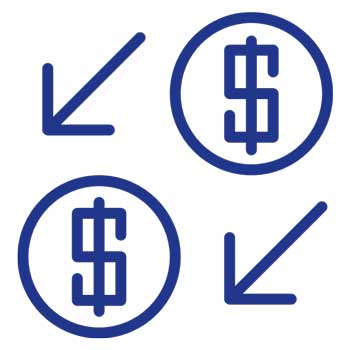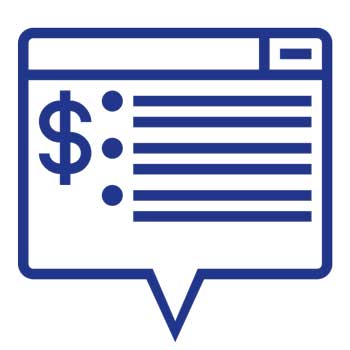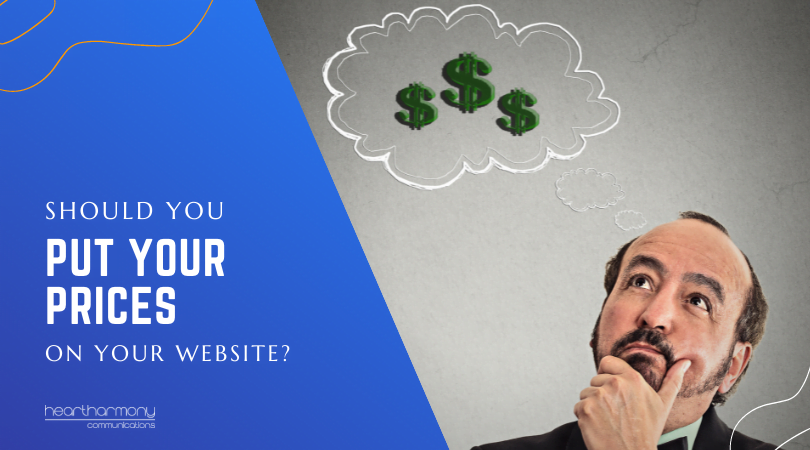Thinking about including your prices on your website? Here are 10 reasons you should include your prices on your website and 8 reasons why you may decide not to.
“How much is it?” (Or if you are a true Aussie, “Owmuchizit?”)
Unless you are one of those billionaires currently exploring migrating into space, before you stick your hand into your digital or old-school cash wallet and fork over your money, you want to know how much something costs.
Your mind then does a few thousand calculations where you compare the cost against a complex mental list of needs, wants, your cash flow, expectations, peer and loved one pressure, and lastly, your ego. If the calculations are successful, then you hand over the money.
We all know that we do it yet asking someone if they will be putting their prices on their website is generally met with all the horror of asking a parent of toddlers if their child would like a red cordial with their meal.
I am not talking about e-Commerce websites here – having prices on these sites is a given. I am talking about your average suburban service or trade-based business. Should you put your prices on your small business website?
10 Reasons You Should Put Prices on Your Website
Placing your prices on your website is a uniquely personal business decision and takes more than a bit of strategic thinking and bravery. I get that!
To help you think through the implications, here are ten reasons you may want to add your prices to your website.
1. Build Trust
Trust is the number one competitive advantage in business. People trust businesses that are open and transparent about their prices and distrust businesses that make you jump through hoops to get a rate. If you want people to trust your business, list your prices.
2. Reduce Tyre Kickers
Not everyone is a good fit for your business. Marketing in your business should attract people who are the best fit for your business while gently discouraging people who are not a great fit.
People who only buy on price will always leave if they see a better price somewhere else.
Publicising your rates helps discourage people who only buy on price from unnecessarily contacting you and wasting your time on calls or emails.
One of my clients is an exceptional concert piano tuner. He tunes pianos for all the big-name international acts that come to his city and for major recordings and performances. He also tunes for schools and even suburban piano musicians with a love of music.
He was constantly bombarded with “Owmuchizit” phone calls from anyone who owned a piano, which naturally impacted his focus on tuning pianos.
After some initial reluctance, we added a prices page to his website. His prices page is consistently his second most popular page, and his tyre kicker calls were reduced by over 90%.
He is now booked three months in advance, and people are happy to wait for him (even though he is one of the most expensive) simply because they know and understand the value he provides.
Displaying your prices reduces tyre kickers who just want to know “Owmuchizit”.
3. Great for Your SEO
Money related searches are some of the most popular searches on the internet. In every industry, one of the most common search terms is “How much does a [website/piano tuner/electrician/plumber etc.] cost in [city].”
One of the easiest ways to rank on Google is to provide comprehensive answers to questions people ask.
Think about it – if one of the most searched questions is how much does your type of service cost, wouldn’t it pay to be near the top of Google with the answer to that question? Do you think you may get more qualified clients who have read your answer and then get in touch to know more?
4. Live Your Brand
What are your brand values? What is important to your business?
Authenticity in business means living your brand values.
For my business, transparency, being down to earth, and clear communication are part of my brand. I am known for telling things like they are, demystifying processes and being ethical.
Sharing my website design rates are just part of living those brand values and not just talking about them.

5. Stop Awkward Conversations
Who else hates the “What is your budget?” “I don’t know – what is your price range?” dance? It is intensely awkward as both sides try not to be the first one to name a figure.
What a waste of time and unnecessary game playing!
I have always hated the “What’s your budget” question. It feels like the person asking it is fishing to try to work out how they can charge as much as they possibly can as it always seems to work out that however much I say, the quote comes in at that or a little bit more.
I believe that it isn’t any of my business to know how much money you have or don’t have.
Let’s cut the awkward game playing, get that elephant out of the room up front and move onto what matters.
6. Remove Unaffordability Myths and Assumptions
Many people meet someone at a networking event or look at a website and think, “I could never afford to hire them.” So, they don’t make the call.
Putting your rates upfront helps dispel the myth that you are out of their reach.
It also helps your clients work out what they need to do to work with you. I have had several clients who have told me, “I never thought I could afford you, but when I checked out your rates, I knew that with just a little bit of saving, I could. So here I am!”
Even more surprising, we, as business owners, often make assumptions about whether someone can afford our services. If we make an incorrect assumption, we don’t chase the sale and potentially lose a brilliant client.
Putting your prices helps get rid of false affordability assumptions on both sides.
7. Reflect Your Brand Positioning Strategy
Every business decides where they sit in comparison to other similar businesses. Where does your brand sit on the market? Are you high, mid-range or low on the market?
Showing your rates reinforces your brand positioning and helps attract the right clients to your business. Not too big or not too small – but just right.
8. Educate Clients
Clients don’t always know how much a particular service in your industry costs. If you take the time to show your rates and explain what goes into that rate, you help create educated clients who are not willing to cut corners to get the service they require.
One of my clients is a tree lopper. This is a very cutthroat industry, and many backyard operators don’t have the correct insurances and cut corners on tool services or safety assessments. Being transparent about what it costs to run a safe, compliant, and ethical business has helped them to win quality clients.
9. Your Competition Does It
People are inordinately comfortable browsing the web to find answers to random questions about a product or service.
If your competitors name their price and you don’t, then who do you think the person will call first?
If you want to remain competitive, you need to match the marketing tactics your competitors use.
If your competitors are not listing their prices, then be the first to help your potential clients and take control of the discussion of rates in the industry.
10. You Have To Answer It At Some Point
There comes a time when every business must answer “Owmuchizit”.
Why not answer it earlier rather than later and save time and hassle for everyone?

Why Don’t People Put Prices on Their Website?
There are many reasons that people choose not to put their prices on their websites. In most cases, these are fears rather than reality.
1. Service is 100% Fully Customised
If you provide a fully customised and unique service for each customer, you may struggle with nailing down a set price.
Many small businesses get around this problem by stating price starting points or average prices for their services rather than fixed rates.
2. Concerned That Competitors Will Undercut Them
Some business owners are concerned that their competitors will see their prices and then undercut their rates.
Newsflash! If your competitors are so aggressive towards you, they already know your rates. They will have had a mate ring up and get a quote from you.
Save yourself the aggravation of doing a quote that goes nowhere, and just put your rates upfront.
And if your clients only go to you because you are the cheapest, it’s time to explore what else makes you unique and different.
3. Want to Connect With People First
Many business owners want to connect with people to talk through their service offerings and how they add value before dropping their prices into the conversation. They want connection first and prices second.
The problem is that clients want to know prices first before they are happy to build a connection. For them, there is no point in connecting with someone they can’t afford.
Clients often don’t hear or take in the sales spiel with that elephant in the room glaring at them. They are just waiting for a polite moment for you to take a breath so they can ask, “Owmuchizit”.
Business owners can find other ways to build initial rapport through the content on their website, including videos, articles or simply the photos and words they use on the website.
Showing your prices upfront means that any rapport building will be more genuine and deeper as the client will focus on what you are saying and not just waiting for you to draw breath.
4. Worry That They Are Undervaluing or Underselling Themselves
Many business owners are uncomfortable with the whole fee thing. They are worried that if they put their prices on their website, they may be undervaluing the service they offer.
Often people new in business end up charging different rates depending on how confident they feel that day.
They are also not confident that they can put the words around the prices on their website so that people will want to buy their services.
This is a very valid concern – particularly for female business owners.
It partly is because money is an undiscussable. For decades, talking about how much your wages were was a dismissible offence in many businesses.
This undiscussability has helped to entrench the wage gap between male and female employees, and people with disabilities and other people in the workforce.
The more you can break down this taboo in your own business, the more you help close the gap across all roles and industries. Think of it as your quiet rebellion towards the patriarchy if that helps.
You may also need a website copywriter to help you put your business benefits into compelling words as writing about yourself can be hard!
One thing to remember: Websites are not carved in stone. You can always change the prices, and you can also use “prices start from” if you are particularly concerned.

5. Worried Their Rates Are Too Low
Rates that are too low can turn off as many clients as if your rates are too high. Too low, and people can assume that you are not very good (whereas you may simply be not very confident).
This is where your market research needs to come into play.
If you are too low on the market, you are not only costing yourself clients but also impacting your business’s ongoing profitability. Find out what your competitors charge and adjust your rates accordingly.
6. Don’t Want to Lose Potential Premium Prices
Some business owners worry that showing their prices will impact their ability to charge a premium if they think the client can wear a higher rate.
If that is how you like to do business, then don’t put your rates on your website. For me, that is not how I like to do business.
7. They Love Selling
Some people simply love the thrill of sales conversations. They love the games and adrenaline rush and are happy to have every conversation as a sales process.
If you are wired that way, then short-circuiting that game by listing your prices upfront can take all the fun out of it. If that is you, don’t put your prices on your website.
If you hate the sales game, then add your prices to your website.
8. Believe Their Client’s Don’t Care About Price
Businesses that sell to premium clients often believe that their clients genuinely don’t care about price.
To those businesses, I suggest you check out the websites of ultra-premium brands such as Cartier, Gucci, Tiffany and Co, Louis Vuitton.
Every single one lists their prices. Why? Because it reinforces their brand of ultra-exclusivity.
While the people who buy these products or services may not care about the price, they care about what it gives them.

Tips For Showing Your Prices on Your Website
If you decide to display your prices on your website, here are a few tips to maximise the result.
Don’t List Everything
Neuromarketing studies show that too much choice confuses people and stops them from choosing.
Don’t try to list every single price point and permutation. Prune your prices on your website back to the most common or essential things that people ask about or buy.
Consider Options
While flat rates are easy to understand, you can also use “Prices start at …”, or “Our fees range from $X to $Y”, or even, “The average fee for our projects is $X.”
Remember, that the lowest rate you list will become a mental anchor for people who visit your site, so make that point a true reflection of what you charge.
If your average project spend is much higher than the prices start from spend, use the average rate, as it is more realistic and will reduce sticker shock.
Wrap Your Prices in Education
Prices should never sit by themselves. They should always be surrounded by benefits and reasons why your rates are excellent.
It also helps to add in testimonials or case studies to help genuinely reinforce that others have found your service helpful.
Pricing Pages Should Have Prices on Them
Don’t be deceptive to try and game Google by having a page headed “Prices” and having a few words of keyword-rich text about prices, but not including any prices, or trying to get people to contact you for pricing.
Clients take a very dim view of this bait and switch tactic. If you have a prices page, then include your prices.
Comply with ACCC Pricing Guidelines
All prices on your website need to comply with rules from central bodies such as the ACCC to ensure your rates are legal, clear and not misleading.
This particularly applies to any comparison rates you may display – either to your competitors or to the rates you previously charged.
Review Them Often
Your prices are not carved in stone. Revisit your pricing page regularly and adjust your rates to reflect supply/demand/skill and confidence.
Last thoughts
As a result of all the societal disruptions of recent years (looking meaningfully at a certain virus), people are more price-sensitive and less trusting of businesses.
Displaying your prices on your website is one small thing you can do to reduce distrust and help potential clients see if they are a fit for your business.
If you are not sure whether adding your prices to your website is for you, then test it out.
Monitor the quality of your leads for a month without adding in prices, and then add your prices either to a services page or a standalone page, and monitor the quality of your leads.
Sometimes, it pays to give things a try!





